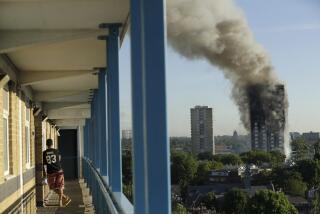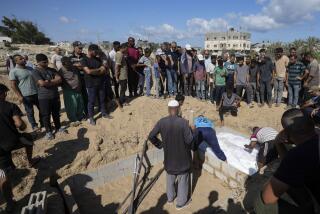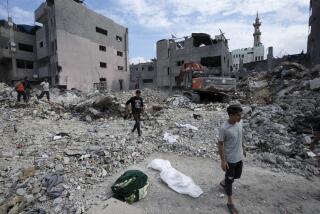Forensic Teams Begin Their Grim Investigative Work
LONDON â As anguished relatives lamented the continued lack of information about missing family members on the fifth day since the London bombings, pathologists on Monday began the gruesome task of combing through the bagged and photographed remains of 52 victims for criminal evidence and formal identification.
Only one of the victims was named as the first coronerâs inquest got underway and forensic teams began the detailed autopsies that threaten to prolong the uncertainty faced by dozens of families for days or even weeks.
Four-person forensic teams worked beneath a sprawl of white tents erected at a military site near the Kingâs Cross rail station, examining the remains in search of shrapnel, burn marks and traces of other victims to reconstruct exact scenarios for each of Thursdayâs four rush-hour bombings.
Many of the bodies brought to the emergency morgue over the weekend are in pieces, and the parts will have to be matched through DNA analysis before they can be brought together for thorough analysis, forensics specialists said. The sheer volume of DNA testing could overwhelm technical capacities, they warned, although no one from the coronerâs office would speak to the question of how long such testing would take.
British Prime Minister Tony Blair made an appeal for patience and an understanding of the need to treat the remains as sources of evidence in pursuit of the bombers.
The coronerâs office âwill make definitive announcements once the procedures have been gone through,â the solemn prime minister told Parliament. âI wish the process could be quicker.â
He noted that âin previous terrorist attacks, mistakes have been made that were terribly distressing,â an apparent reference to the delivery of one victimâs remains to the wrong U.S. relatives after the 1988 bombing of a Pan Am jet over Scotland.
Metropolitan Police Commissioner Ian Blair, no relation to the prime minister, also appealed to the grieving relatives to âgive us time.â
âHowever terrible it is, we must take our time in identifying people,â the police chief said after laying a floral tribute at the Kingâs Cross Station, where at least 21 people died. âThis is the biggest investigation in English history.â
The explanations were little comfort to those like Marie Fatayi-Williams, who raged tearfully near the site of the Tavistock Square blast scene where she believes her son Anthony might have been killed aboard a double-decker bus in the last of Thursdayâs explosions on Londonâs mass transit system.
âThis is the fifth day. Five days on! Five days on!â the distraught mother who flew here from Nigeria over the weekend wailed as she clutched a picture of her 26-year-old son. âI need to know what happened to Anthony. Heâs the light of my life.â
In a voice filled with grief, she condemned the perpetrators, demanding to know: âWhose cause has been served? Certainly not the cause of God, not the cause of Allah!â
Even victimsâ friends and relatives persuaded of the need for the time-consuming procedures conceded that they were suffering emotional trauma.
âWeâre terribly frustrated and confused and shocked,â said David Golovner, a lifelong friend of Michael Matsushita, a 37-year-old American.
Golovner and Matsushitaâs parents, who flew here from New York on Saturday, have provided police with some of the missing manâs belongings for fingerprints and DNA samples. Police have told them that there was âvirtually no possibility of his having survived,â although formal identification has yet to be made, Golovner said.
Forensics experts say methodical procedures are essential because autopsy evidence can provide clues to the identity and methods of perpetrators, as happened when parts of a timing device were found in the corpse of a victim after the 1989 Irish Republican Army bombing of a military barracks in the English county of Kent.
âThe first thing they must do is X-ray everyone, which you wouldnât do routinely,â said Christopher Milroy, a professor of forensic pathology at the University of Sheffield who has directed past examinations involving mass casualties. The X-rays show whether metal bomb fragments or explosives parts are embedded in the bodies.
The teams made up of a pathologist, a mortuary technician, a detective and an evidence officer then systematically remove and record clothing and jewelry on the victim before examining the remains for substance traces or surgically extracting tissue and organs for laboratory analysis.
A coronerâs inquest requires the autopsy teams to make four determinations, Milroy explained: the identity of the deceased as well as the time, location and cause of death.
Ideally, the coroner wants to keep together the remains from such large-scale attacks until all identities have been made and all evidence gleaned, he said. But with the expectation in this case that some identifications will take weeks longer than others, the coronerâs office is likely to be under tremendous pressure to release the remains to relatives as each victimâs autopsy is completed, Milroy said.
On Monday, London Coroner Andrew Reid opened the first of numerous expected inquests with the disclosure that Susan Levy, a 53-year-old mother of two grown sons, had died of âinjuries caused from an explosionâ after being taken to Royal London Hospital from the blast scene on the Piccadilly train line.
The public identification of Levy might have come first because she died in a hospital, as opposed to succumbing at the blast site and becoming part of the crime scene.
âSusan was a devoted and much-loved wife and mother of two sons,â her husband, Harry Levy, said in a statement. âWe are all distraught at her needless loss and our thoughts and our prayers are also with the many other families who have been affected by this horrendous tragedy.â
Police raised the confirmed death toll to 52 but gave no explanation of how the new figure was reached. Recovery workers spent the weekend removing bodies and parts from the wreckage on the Piccadilly line, where bodies or fragments in addition to the previously counted 21 fatalities might have been found. Clearing the Piccadilly tunnel was slowed by intense heat and the stench of decay, police said.
Conditions in the tunnel improved somewhat Monday, said Deputy Chief Constable Andy Trotter. Ventilation was resumed once investigators were certain theyâd collected evidence that might have been at risk of blowing away, allowing the temperature to drop significantly from the 140 degrees over the weekend, Trotter said.
At the Tavistock Square crime scene, investigators towed away vehicles for forensic examination.
*
Times staff writer Tracy Wilkinson contributed to this report.
More to Read
Sign up for Essential California
The most important California stories and recommendations in your inbox every morning.
You may occasionally receive promotional content from the Los Angeles Times.











